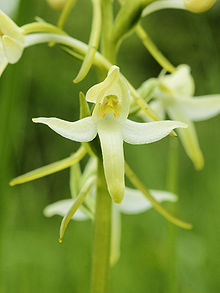Platanthera
| Platanthera | |
|---|---|
 |
|
| Platanthera bifolia | |
| Scientific classification | |
| Kingdom: | Plantae |
| (unranked): | Angiosperms |
| (unranked): | Monocots |
| Order: | Asparagales |
| Family: | Orchidaceae |
| Tribe: | Orchideae |
| Subtribe: | Orchidinae |
| Genus: |
Platanthera Rich. |
| Type species | |
|
Platanthera bifolia (L.) Rich. |
|
| Synonyms | |
|
|
The genus Platanthera belongs to the subfamily Orchidoideae of the family Orchidaceae, and comprises about 100 species of orchids. The members of this genus, known as the butterfly orchids or fringed orchids, were previously included in the genus Orchis, which is a close relative (along with the genus Habenaria). They are distributed throughout the temperate regions of the Northern Hemisphere. They are terrestrial and have tubercules.
Orchids get their name from the Greek word "orchis", meaning "testicle", based on the appearance of the underground tubercles in some terrestrial species. The word "orchis" was used by Theophrastus for the first time (371/372 – 287/286 B.C.), in his book "De Historia Plantarum" (On the Natural History of Plants). He was student of Aristotle and it is considered the father of botany and ecology.
Louis Claude Richard chose the name Platanthera for this genus; it comes from the Greek and means "broad or wide anther," referring to the separation of the base of the pollinia in the type species of the genus. Richard felt that this characteristic distinguished the genus Platanthera from both the genus Orchis and the genus Habenaria. However, today the defining characteristics of the genus are generally accepted to be the absence of both stigmatic processes (typical in Habenaria) and ovoid root-tuberoids (characteristic of both Habenaria and Orchis). Still, P. nivea, P. clavellata and P. integra all have stigmatic processes, showing the limitations of morphological characteristics in defining this clade.
...
Wikipedia
